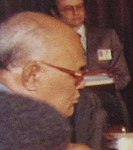
Politics of Samoa takes place in a framework of a parliamentary representative democratic state whereby the Prime Minister of Samoa is the head of government. Existing alongside the country's Western-styled political system is the fa'amatai chiefly system of socio-political governance and organisation, central to understanding Samoa's political system.

The Samoan National Development Party (SNDP) was a political party in Samoa, and the country's main opposition party between 1988 and 2003.
Matatumua Maimoana (1935–2012), also known as Matatumua Maimoaga Vermeulen, was a matai, politician, Nurse and Environmentalist of Samoa. Her chief title, Matatumua, was an orator's title from the village of Faleasiu. She was a former member of parliament in Samoa and the founder of the Samoa All People's Party (SAPP), becoming the first woman to lead a political party in the country. SAPP allowed people as young as 16, regardless of gender or whether they were matai to be officers in the organisation which included village branches. She was a founding member of the Human Rights Protection Party (HRPP), which has dominated Samoan politics in the last two decades.
Aiono Nonumalo Sofara is a chief (matai) and former Member of Parliament in Samoa. He was a member of the Human Rights Protection Party (HRPP) and later the Samoan National Development Party (SNDP).
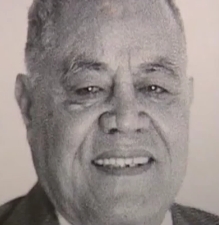
Vaʻai Kolone was the fourth prime minister of Samoa and a founder of the Human Rights Protection Party (HRPP) in Samoa. He served as Prime Minister twice, first between 13 April and 18 September 1982, and then from 30 December 1985 until 8 April 1988.
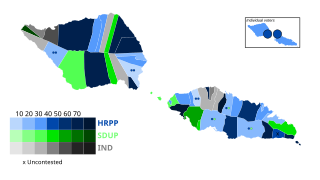
General elections were held in Samoa on 31 March 2006 to determine the composition of the 14th Parliament. The main contesting parties were that of incumbent Prime Minister Tuilaʻepa Saʻilele Malielegaoi, of the Human Rights Protection Party (HRPP); and the Samoan Democratic United Party (SDUP). In addition, three other parties, the Christian Party (SCP), the Samoa Party (SP), and the Samoa Progressive Party (SPP), competed in the election. The result was a landslide victory for the HRPP, which won 33 of the 49 seats. The newly founded SDUP secured ten seats, and the remaining six were won by independents. After the election, three independents joined the HRPP, increasing the party's seat count to 36.

General elections were held in Samoa on 2 March 2001 to determine the composition of the 13th Parliament. Prime minister Tuilaʻepa Saʻilele Malielegaoi led the Human Rights Protection Party (HRPP) into the election. Opposition leader and former prime minister and future head of state, Tui Ātua Tupua Tamasese Efi led the Samoan National Development Party (SNDP) into the election. The HRPP won 23 seats, but initially fell short of a majority. The SNDP won 13 seats, the Samoan United People's Party secured one seat and the remaining 12 were won by independents. Following the election, all 12 independents joined the HRPP, giving the party a majority in parliament and allowing Tuila'epa to remain prime minister.

General elections were held in Western Samoa on 26 April 1996. The Human Rights Protection Party (HRPP) emerged as the largest party, but just short of a majority with 24 of the 49 seats. The Samoan National Development Party won eleven seats, the Samoa Liberal Party one and independents thirteen. Following the elections, the twelfth Samoan Parliament was sworn in on 16 May 1996. The HRRP was able to form a government with the support of ten of the independent MPs.

General elections were held in Samoa on 4 March 2011, to determine the composition of the 15th Parliament. Two parties contested the election, the ruling Human Rights Protection Party (HRPP), which had been in power for most of the time since 1982, led by Prime Minister Tuilaʻepa Saʻilele Malielegaoi and the newly founded Tautua Samoa Party (TSP) led by Vaʻai Papu Vailupe, which several minor parties had merged into. The election occurred following amendments to the electoral act in 2009, including the introduction of the Monotoga law, a requirement for aspiring candidates to dedicate traditional village service and commitments. As a result, three TSP aspiring candidates, including a challenger for the prime minister's seat, were disqualified by the Supreme Court for failing to satisfy this law.

General elections were held in Western Samoa on 7 February 1970. All candidates ran as independents, with voting restricted to matais and citizens of European origin, with the matais electing 45 MPs and Europeans two. Following the election, Tupua Tamasese Lealofi IV became Prime Minister.

General elections were held in Western Samoa on 24 February 1973. All candidates ran as independents and voting was restricted to matai and citizens of European origin, with the matai electing 45 MPs and Europeans two. Following the election, Fiame Mata'afa became Prime Minister for a second term, having previously held the office between 1959 and 1970.

General elections were held in Western Samoa on 21 February 1976. All candidates ran as independents and voting was restricted to Matai and citizens of European origin, with the Matai electing 45 MPs and Europeans two. Following the election, Tupuola Efi became Prime Minister.

General elections were held in Western Samoa on 27 February 1982. The Human Rights Protection Party won 22 of the 47 seats in the Legislative Assembly and was able to form a government after three independents voted for its leader, Va'ai Kolone, in the vote for Prime Minister.

General elections were held in Samoa on 4 March 2016 to determine the composition of the 16th Parliament. Two parties contested the election, the ruling Human Rights Protection Party (HRPP), led by Prime Minister Tuilaʻepa Saʻilele Malielegaoi, which had been in government for most of the time since 1982 and the Tautua Samoa Party (TSP), led by Opposition Leader Palusalue Faʻapo II.

General elections were held in Western Samoa on 15 November 1957.
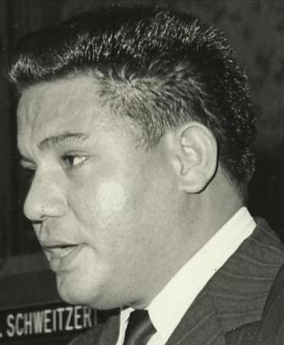
Tuatagaloa Tofa Siaosi was a Western Samoan politician. He served as a member of the Legislative Assembly from 1967 until 1973 and was Minister of Finance between 1970 and 1973.

General elections were held in Samoa on 9 April 2021 to determine the composition of the 17th Parliament. The Human Rights Protection Party (HRPP), which had been in government for most of the time since 1982, was led into the election by Tuilaʻepa Saʻilele Malielegaoi, who had served as prime minister since 1998. The passage of the controversial Land and Titles bills by the HRPP led some party members to defect, establishing the Faʻatuatua i le Atua Samoa ua Tasi (FAST) party promising a repeal. FAST elected Fiamē Naomi Mataʻafa, the daughter of Samoa's first prime minister, as leader shortly before the election; she left the ruling party and resigned as deputy prime minister in 2020, also in opposition to the amendments.
Faʻasoʻotauloa Pati Taulapapa is a Samoan politician and former Cabinet Minister. He is a member of the Human Rights Protection Party.
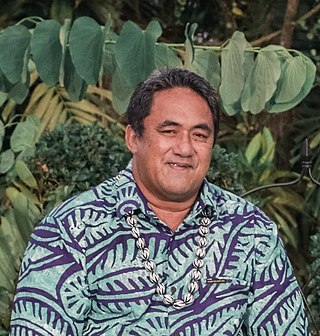
Alai'asa Moefa'auouo Tapuai Sepulona Moananu is a Samoan politician. He is a member of the Opposition Human Rights Protection Party and the current member for the Anoama'a No.1 constituency. Moananu is also the Whip for the HRPP.
Mase Fetuao Toia Fiti Alama OM was a Samoan doctor and civil servant. She served as Clerk of the Legislative Assembly of Samoa, Registrar of Electors, and Chief Electoral Officer of Samoa.

